2017年CFA一级公式表
- 格式:pdf
- 大小:795.30 KB
- 文档页数:10

cfa一级十科笔记CFA一级考试是金融行业中非常重要的职业资格认证,涵盖了广泛的金融知识领域。
下面是关于CFA一级考试十科的笔记,以帮助你更好地准备考试。
1. 伦理与专业标准(Ethics and Professional Standards):了解职业道德和行业规范的重要性。
理解与客户、公司和市场参与者之间的关系。
掌握投资专业人士应遵循的道德准则。
2. 数量方法(Quantitative Methods):熟悉基本的数学和统计概念。
掌握概率论和假设检验的基本原理。
理解回归分析和时间序列分析的基本概念。
3. 经济学(Economics):理解宏观经济和微观经济的基本原理。
掌握货币政策、财政政策和国际贸易的影响。
理解经济指标和金融市场之间的关系。
4. 金融报表分析(Financial Reporting and Analysis):理解财务报表的结构和内容。
掌握财务比率分析和财务报表的解读。
熟悉资产负债表、利润表和现金流量表之间的关系。
5. 公司金融(Corporate Finance):理解资本预算和资本结构的基本原理。
掌握投资决策和融资决策的方法。
熟悉公司治理和股权结构的影响。
6. 证券投资(Equity Investments):理解股票市场和股票投资的基本原理。
掌握股票估值和投资组合管理的方法。
熟悉股票投资的风险管理和绩效评估。
7. 固定收益投资(Fixed Income Investments):理解债券市场和债券投资的基本原理。
掌握债券估值和债券组合管理的方法。
熟悉利率风险和信用风险的评估和管理。
8. 衍生品投资(Derivative Investments):理解衍生品市场和衍生品投资的基本原理。
掌握期权、期货和其他衍生品的估值和交易策略。
熟悉衍生品投资的风险管理和绩效评估。
9. 另类投资(Alternative Investments):理解另类投资市场和另类投资的基本原理。
掌握房地产、私募股权和大宗商品等另类投资的特点和风险。
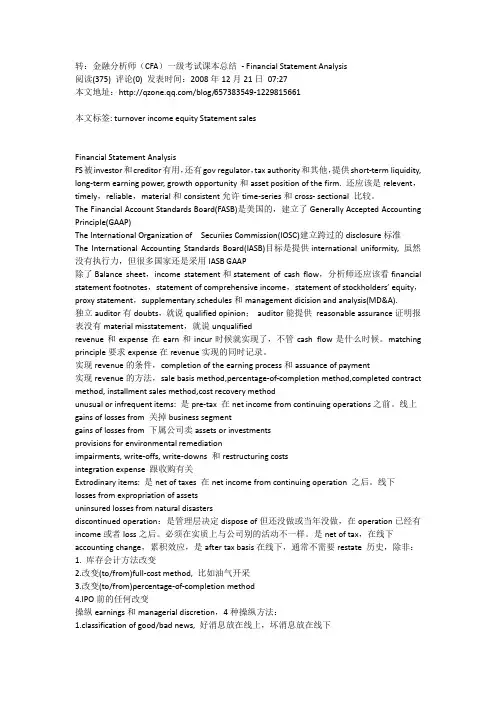
转:金融分析师(CFA)一级考试课本总结- Financial Statement Analysis阅读(375) 评论(0) 发表时间:2008年12月21日07:27本文地址:/blog/657383549-1229815661本文标签: turnover income equity Statement salesFinancial Statement AnalysisFS被investor和creditor有用,还有gov regulator,tax authority和其他,提供short-term liquidity, long-term earning power, growth opportunity和asset position of the firm. 还应该是relevent,timely,reliable,material和consistent允许time-series和cross- sectional 比较。
The Financial Account Standards Board(FASB)是美国的,建立了Generally Accepted Accounting Principle(GAAP)The International Organization of Securiies Commission(IOSC)建立跨过的disclosure标准The International Accounting Standards Board(IASB)目标是提供international uniformity, 虽然没有执行力,但很多国家还是采用IASB GAAP除了Balance sheet,income statement和statement of cash flow,分析师还应该看financial statement footnotes,statement of comprehensive income,statement of stockholders’ equity,proxy statement,supplementary schedules和management dicision and analysis(MD&A).独立auditor有doubts,就说qualified opinion;auditor能提供reasonable assurance证明报表没有material misstatement,就说unqualifiedrevenue和expense在earn和incur时候就实现了,不管cash flow是什么时候。
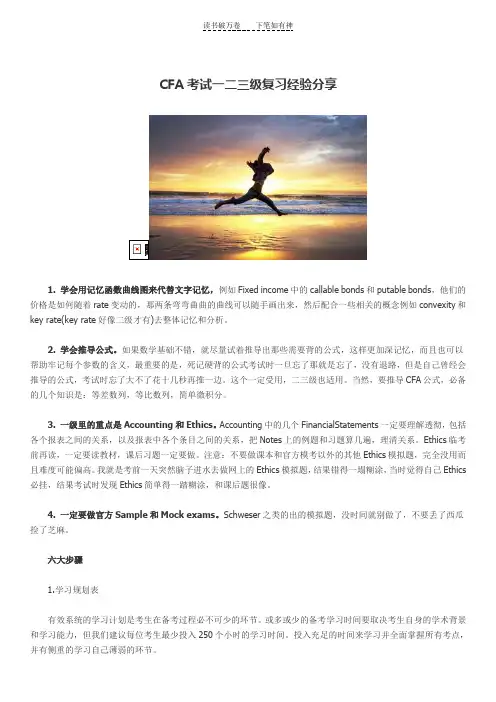
2.投入学习的时间相应调整学习时间的安排,有侧重的并有效的来规划学习时间。
CFA每个级别都有18个章节,考生每周最少要花10-15个小时,持续18个星期的时间来学习协会指定的内容,考生制定的考前时间规划表要在考前30-45天完成所有知识的第一次学习。
考前最后4-6周的时间,考生要巩固前面所学的内容,做好习题的演练,其中一定要包括协会的samplequestion和mockexam。
3.精读CFA的知识体系(CandidateBodyofKnowledge简称CBOK)和协会的教材(curriculum)细分并详述了投资行业各个部分的要点。
建议考生一般先看SchweserStudyNotes,将每一个Session都学习之后,如果有不理解的知识点,可以通过Curriculum对相应的内容进行查看。
对于一级考生,重点学习Level1的SchweserStudyNotes辅助CFA协会官方教材的章节习题及道德手册就可以了。
4.计算器的使用熟练掌握CFA指定的金融计算器,仅三种计算器(BAIIPlus、BAIIPlusProfessional、HP12C)可带入考场,推荐考生使用性价比较高的德州仪器BAIIPlus。
5.复习阶段学习是一个逐步积累的过程,要成体系的看待自己学习的知识。
考生要不断夯实基础,温故知新。
考生都要不断的温习以前学过的知识。
6.习题冲刺阶段针对考试,CFA协会每年都会提供online questions,帮助考生做好相关准备,大致预测考试所需时间。
模拟试题都会紧扣考纲,题型和结构都满足CFA协会的相关要求。
Level 2准备时间了两个月,成绩全A。
这个就是我说反面教材的例子了。
一级轻松到手之后,飘飘然了,立刻报了来年二级,但是直到四月还在看第一本Notes。
如果说一级用三个月准备还算合理,那二级准备两个月就和自杀是差不多的节奏。
结果到后来我就急了,两个月时间,要完成我读三遍Notes的目标,就必须废寝忘食。

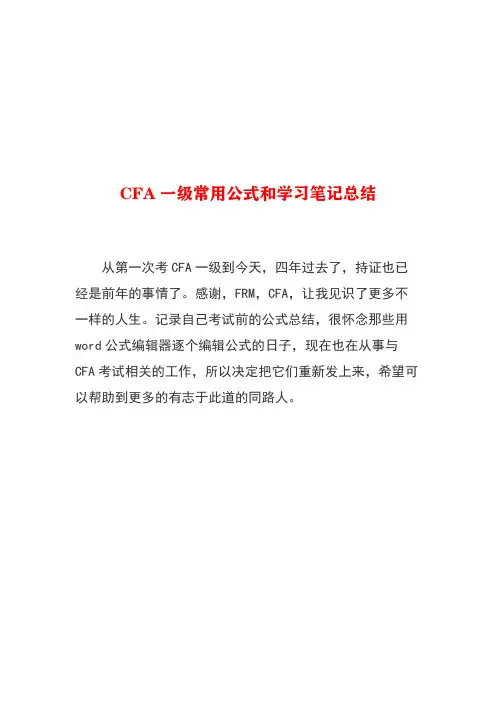
CFA一级常用公式和学习笔记总结从第一次考CFA一级到今天,四年过去了,持证也已经是前年的事情了。
感谢,FRM,CFA,让我见识了更多不一样的人生。
记录自己考试前的公式总结,很怀念那些用word公式编辑器逐个编辑公式的日子,现在也在从事与CFA考试相关的工作,所以决定把它们重新发上来,希望可以帮助到更多的有志于此道的同路人。
Statistic (5)1.1 Standard error of the sample mean: (5)1.2Measure of performance (5)1.3远期利率公式: (6)1.4 Leptokurtotic: (6)1.5 Positive skewed (6)1.6 Holding period return(HPR) (7)1.7 arithmetic or mean return (7)1.8 Geometric Mean return (7)1.9 Money-weighted return or time-weighted return (8)1.10 quartiles/quintiles/deciles/percentiles (8)1.11 probability (9)1.12 ratio/ordinal/interval/nominal (9)1.13 Chebyshev’s Inequality (9)1.14 distribution (10)1.15 desirable properties of an estimator (10)1.16 Bayes’ formula (10)1.17 type I and type II error (10)1.18 hypothesis testing (11)1.19 technical analysis (13)derivatives (16)2.1 option portfolio (16)2.2 Put-call parity (16)2.3 backwardation \contango (16)Corporate finance (16)3.1 NPV (16)3.2 IRR(internal rate of return) (17)3.3 PBP(backed period) (17)3.4DPB(discounted backed period) (17)3.5 Profitable index(PI) (17)3.6 WACC (17)3.7 cost of debt (18)3.8 Cost of preferred stock (18)3.9 Cost of equity (18)3.10 Break point (20)3.11 Floatation cost (20)3.12 Degree of operating leverage (21)3.13 Degree of financial leverage(DFL) (21)3.14 Degree of total leverage(DTL) (21)3.15 Breakeven Analysis (22)3.16 working capital management (22)3.17 Liquidity ratios and turnover ratios (22)portfolio (23)4.1 nominal 与real之间的转换 (23)4.2 portfolio’s deviation (24)4.3 Many risk assets (24)4.4 MPT理论 (24)4.5 Capital allocating line(CAL) (25)4.6 beta : a measure of systematic risk (26)FINANCIAL REPORTING (27)5.1 应收应付/预收预付 (27)5.2 audit report (27)5.3 Footnotes/MD&A/proxy statement (28)5.4 美国准则和国际准则 (30)5.5 IFRS对sales of goods销售商品收入确认的方法 (31)5.6 IFRS对rendering of service?收入确认的方法 (32)5.7 Financial statement Elements (32)5.8 steps in the financial statement analysis framework (33)5.9 Revenue recognition criteria (33)5.10 Revenue recognition (34)5.11 installment sales and cost recovery method (35)5.12 accounting equation 有计算 (36)5.13 income statement其它处理 (37)5.14 income statement线下项目 (38)5.15 EPS计算 (39)5.16 comprehensive income (40)5.17 金融资产与负债的计量有计算 (40)5.18 bad debt计算坏账 (41)5.19 CFO直接法与间接法有计算 (41)5.20 CFI和CFF的计算 (42)5.21 FCFE和FCFF的计算 (43)5.22 CF中的其它知识点 (44)5.23 financial analysis techniques (44)5.24 inventory 理解 (47)5.25 depreciation 理解 (50)5.26 impairment 理解 (51)5.27 capitalized and expense 的理解 (52)5.28 investment property (new) (54)5.29 early repayment of bond (55)5.30 issuance cost of bond (56)5.31 debt security 理解 (57)5.32 defer tax 理解 (59)5.33 承租人和出租人理解 (64)5.34 off-balance sheet (66)5.35 ratio (68)5.37 cash management manipulation (68)Economics (70)6.1 Utility Theory and indifference Curves (70)6.2 Economic profit and accounting profit (70)6.3 elasticity (70)6.4 Cross elasticity of demand, (71)6.5 盈亏平衡点 (71)6.6 GDP的定义: (71)6.7 nation income (72)6.8 GDP deflator: GDP平减指数 (73)6.9 IS-LM model (74)6.10 LM曲线是指货币市场的均衡。
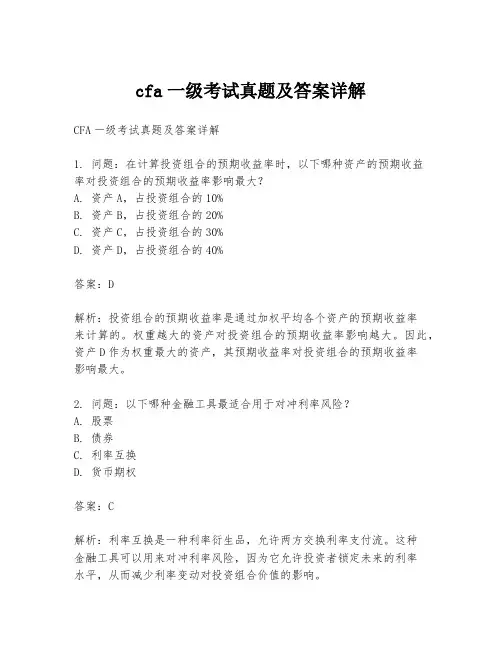
cfa一级考试真题及答案详解CFA一级考试真题及答案详解1. 问题:在计算投资组合的预期收益率时,以下哪种资产的预期收益率对投资组合的预期收益率影响最大?A. 资产A,占投资组合的10%B. 资产B,占投资组合的20%C. 资产C,占投资组合的30%D. 资产D,占投资组合的40%答案:D解析:投资组合的预期收益率是通过加权平均各个资产的预期收益率来计算的。
权重越大的资产对投资组合的预期收益率影响越大。
因此,资产D作为权重最大的资产,其预期收益率对投资组合的预期收益率影响最大。
2. 问题:以下哪种金融工具最适合用于对冲利率风险?A. 股票B. 债券C. 利率互换D. 货币期权答案:C解析:利率互换是一种利率衍生品,允许两方交换利率支付流。
这种金融工具可以用来对冲利率风险,因为它允许投资者锁定未来的利率水平,从而减少利率变动对投资组合价值的影响。
3. 问题:在进行财务分析时,以下哪种比率最能反映公司的流动性状况?A. 流动比率B. 速动比率C. 资产负债率D. 权益乘数答案:A解析:流动比率是衡量公司短期偿债能力的指标,它通过比较公司的流动资产和流动负债来计算。
一个较高的流动比率表明公司有足够的流动资产来覆盖其短期负债,因此最能反映公司的流动性状况。
4. 问题:在计算经济增加值(EVA)时,以下哪个因素不是必要的?A. 公司的税后营业利润B. 公司的资本成本C. 公司的总资产D. 公司的权益乘数答案:D解析:经济增加值(EVA)是通过从公司的税后营业利润中减去资本成本来计算的。
资本成本反映了公司资本的机会成本,而权益乘数并不是计算EVA所必需的。
EVA的计算公式为:EVA = NOPAT - (WACC * 资本投入)。
结束语:通过以上对CFA一级考试真题的分析,可以看出,理解各个金融概念和工具的基本原理对于通过考试至关重要。
希望这些真题及答案详解能够帮助考生更好地准备考试,提高通过率。
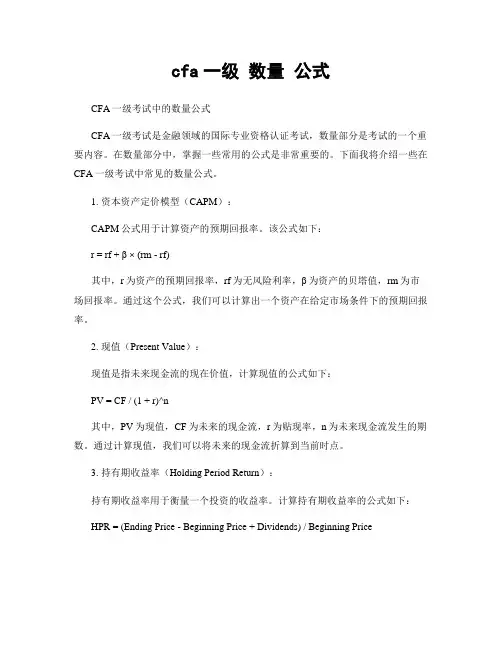
cfa一级数量公式CFA一级考试中的数量公式CFA一级考试是金融领域的国际专业资格认证考试,数量部分是考试的一个重要内容。
在数量部分中,掌握一些常用的公式是非常重要的。
下面我将介绍一些在CFA一级考试中常见的数量公式。
1. 资本资产定价模型(CAPM):CAPM公式用于计算资产的预期回报率。
该公式如下:r = rf + β × (rm - rf)其中,r为资产的预期回报率,rf为无风险利率,β为资产的贝塔值,rm为市场回报率。
通过这个公式,我们可以计算出一个资产在给定市场条件下的预期回报率。
2. 现值(Present Value):现值是指未来现金流的现在价值,计算现值的公式如下:PV = CF / (1 + r)^n其中,PV为现值,CF为未来的现金流,r为贴现率,n为未来现金流发生的期数。
通过计算现值,我们可以将未来的现金流折算到当前时点。
3. 持有期收益率(Holding Period Return):持有期收益率用于衡量一个投资的收益率。
计算持有期收益率的公式如下:HPR = (Ending Price - Beginning Price + Dividends) / Beginning Price其中,HPR为持有期收益率,Ending Price为持有期结束时的价格,Beginning Price为持有期开始时的价格,Dividends为持有期内获得的股息。
通过计算持有期收益率,我们可以评估一个投资的盈利能力。
以上是CFA一级考试中常见的一些数量公式。
熟练掌握这些公式将有助于提高我们在考试中的表现,同时也对实际的金融分析和投资决策有一定的指导作用。
希望以上内容能对您有所帮助。
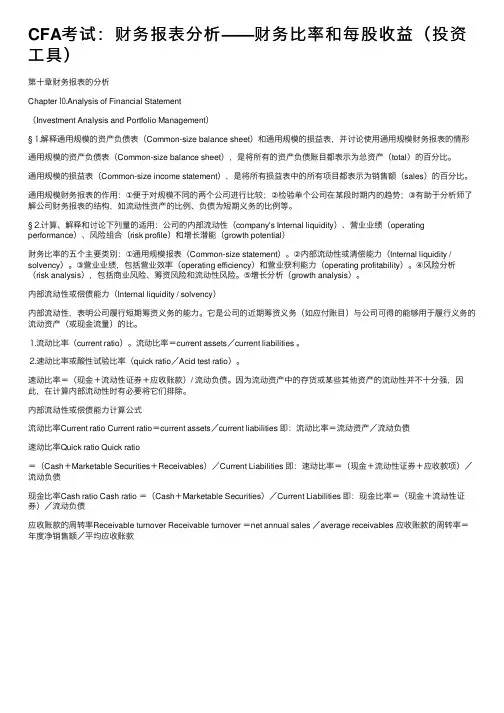
CFA考试:财务报表分析——财务⽐率和每股收益(投资⼯具)第⼗章财务报表的分析Chapter ⒑Analysis of Financial Statement(Investment Analysis and Portfolio Management)§⒈解释通⽤规模的资产负债表(Common-size balance sheet)和通⽤规模的损益表,并讨论使⽤通⽤规模财务报表的情形通⽤规模的资产负债表(Common-size balance sheet),是将所有的资产负债账⽬都表⽰为总资产(total)的百分⽐。
通⽤规模的损益表(Common-size income statement),是将所有损益表中的所有项⽬都表⽰为销售额(sales)的百分⽐。
通⽤规模财务报表的作⽤:①便于对规模不同的两个公司进⾏⽐较;②检验单个公司在某段时期内的趋势;③有助于分析师了解公司财务报表的结构,如流动性资产的⽐例、负债为短期义务的⽐例等。
§⒉计算、解释和讨论下列量的适⽤:公司的内部流动性(company's Internal liquidity)、营业业绩(operating performance)、风险组合(risk profile)和增长潜能(growth potential)财务⽐率的五个主要类别:①通⽤规模报表(Common-size statement)。
②内部流动性或清偿能⼒(Internal liquidity / solvency)。
③营业业绩,包括营业效率(operating efficiency)和营业获利能⼒(operating profitability)。
④风险分析(risk analysis),包括商业风险、筹资风险和流动性风险。
⑤增长分析(growth analysis)。
内部流动性或偿债能⼒(Internal liquidity / solvency)内部流动性,表明公司履⾏短期筹资义务的能⼒。
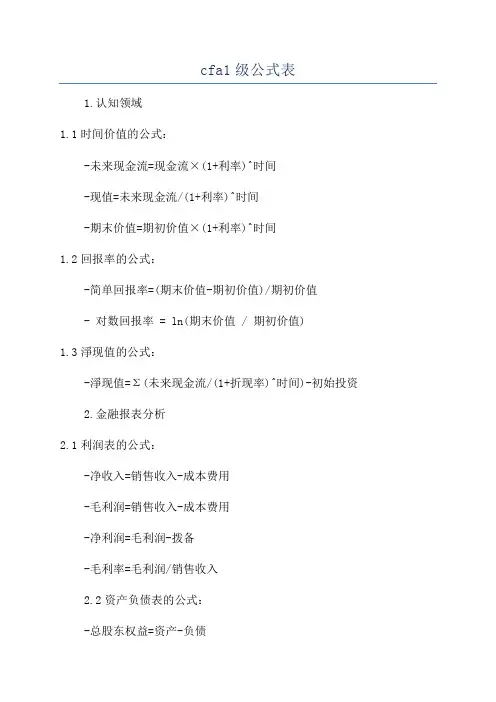
cfa1级公式表1.认知领域1.1时间价值的公式:-未来现金流=现金流×(1+利率)^时间-现值=未来现金流/(1+利率)^时间-期末价值=期初价值×(1+利率)^时间1.2回报率的公式:-简单回报率=(期末价值-期初价值)/期初价值- 对数回报率 = ln(期末价值 / 期初价值)1.3淨现值的公式:-淨现值=Σ(未来现金流/(1+折现率)^时间)-初始投资2.金融报表分析2.1利润表的公式:-净收入=销售收入-成本费用-毛利润=销售收入-成本费用-净利润=毛利润-拨备-毛利率=毛利润/销售收入2.2资产负债表的公式:-总股东权益=资产-负债3.市场组合3.1市场组合的预期收益率:-市场组合的预期收益率=Σ(预期收益率×比例权重)3.2系统性风险的量化方法:-β系数=协方差(个别资产收益率,市场组合收益率)/方差(市场组合收益率)-投资组合的β系数=Σ(资产β系数×资产比例权重)4.证券投资4.1常见股票估值模型:-价格盈利比=股票价格/每股盈利-市净率=股票价格/每股净资产-股利贴现模型=(下一期股息/(折现率-成长率))4.2债券价格估值模型:-债券价格=Σ(每期现金流/(1+收益率)^时间)5.生产者理论5.1短期和长期成本和收益:-生产函数=技术水平×劳动力×资本-平均成本=总成本/产量-边际成本=总成本的变化/产量的变化-边际产品=产量的变化/劳动力的变化5.2规模报酬递增、不变和递减:-规模报酬递增=边际产品>平均产品-规模报酬不变=边际产品=平均产品-规模报酬递减=边际产品<平均产品以上只是CFA1级考试的一小部分公式和定义。
如果您需要详细了解所有公式,请参阅官方教材和考试指南。
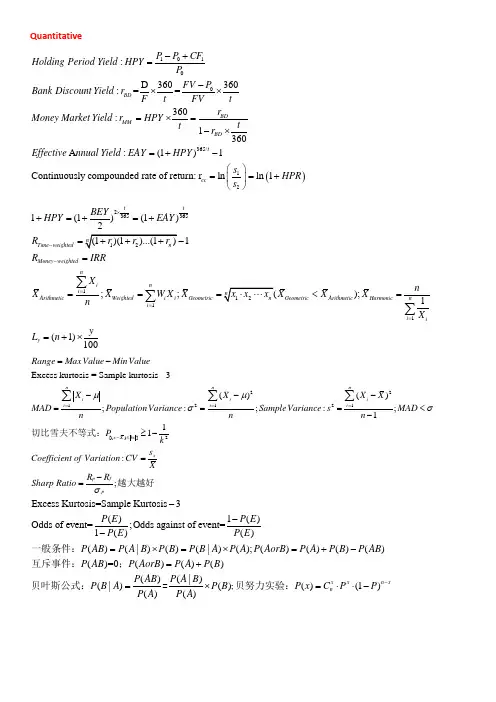
Quantitative1010365/:D 360360:==360:1360A :(1)1Continuously compounded rate of re BD BD MM BD t P P CF Holding Period Yield HPY P FV P Bank Discount Yield r F t FV tr Money Market Yield r HPY t t r Effective nnual Yield EAY HPY -+ =- ⨯⨯ =⨯=-⨯ =+-()12turn: r ln ln 1cc s HPR s ⎛⎫==+ ⎪⎝⎭23653651111(1)(1)21;;);1t tTime weighted Money weighted nini Arithmetic Weighted i i Geometric Geometric Arithmetic Harmonic ni i iy BEY HPY EAY R R IRR Xn X X W X X X X X n X L ⨯--===+=+=+=====<==∑∑∑(1)100y n +⨯2222111[()]2Excess kurtosis = Sample kurtosis - 3()();:;:;111nnniiii i i x X ks Range MaxValue MinValue XXXX MAD PopulationVariance SampleVariance s MAD n nn P k Coefficient of Variat μμσσ===-≤= ----===<-≥- ∑∑∑切比雪夫不等式::;xp fpsion CV XR R Sharp Ratio σ=- =越大越好Excess Kurtosis=Sample Kurtosis 3()1()Odds of event=;Odds against of event=1()()()(|)()(|)();()()()()()=0()()()()(|)()P E P E P E P E P AB P A B P B P B A P A P AorB P A P B P AB P AB P AorB P A P B P AB P B A P A ---=⨯=⨯=+-=+=一般条件:互斥事件:;贝叶斯公式:(|)()()(1)()x x n xn P A B P B P x C P P P A -⨯=⋅⋅-=;贝努力实验:2221,2121,21111222212221122121,21;()[()()][()()]()[()()][()()]()();290% Confidence interval for X is 1.65 ; 95% for 1.96A B A B n p p i i i Cov Cov P A B P A E r P B E r P A B P A E r P B E r E R w E R w w w w Cov X s X s ρσσσσσ===⋅-⋅-+⋅-⋅-=⋅=++±±∑2) ; 95% for 2.58~(,),;()1()(Roy's Safety-first Ratio=;Minimum Acceptable Returnp LL pX sx X N Z F z F z E R R R μμσσσ±-=-=--=/2/20000000000Confidence interval: point Estimate;One tail:,;,;Two tail:,Reject :;F X Z X Z X Z H H H H H H H test statistic critical value αααααμμμμμμ=±≥<≤>== >中心极限定理:0ail to reject ::~(0,1);:~(1)H test statistic critical value X X Z test Z N t test t t n < -=-=-22221121222212121/222212121(1) :~(1);:(S S )~(1,1)Test for equality of means: t-statistic=(Sample Variances assumed unequal);t-statistic=PPs n s chi Square test x x n F test F F n n s x x x x s s s s n n n σ--=--=>----⎛⎫++ ⎪⎝⎭条件:1/222(equal)n ⎛⎫ ⎪⎝⎭Portfolio Management22221,21212221122121,2,,2()()():()[()]pM f p f pM i mkti i i mkt mktmkti f i M f p fpCov w w w w Cov E R R CML E R R Total Risk systematic Risk unsystematic RiskCov SML CAPM E R R E R R R R Sharpe Ratio ρσσσσσσσσβρσσβσ==++-⎡⎤:=+⎢⎥⎣⎦= + ==⨯=+-- =;()();'()()Mp f M f pp fp p f p M f pM Squared R R R R R R Treynor Measure Jensen s R CAPM R R R R σσαββ-=---- ==-=---Economics%;1,;1,%Pr %;0,normal good(0<<1,necessity good;>1,Luxury);e 0,inferior good%%%Price of related g p p i i i i QOwn price elasticity e elastic e inelasticice QIncome elasticity e e e IncomeQCross elasticity ∆- =><∆∆ =><∆∆ =∆;0,;0,oodbreakeven point if AR=ATC(Perfect competition);TR=TC(imperfect competition)shutdown point if AR<AVC(Perfect competition);TR<TVC(imperfect competition)TR=P Q;AR=TR/Q;c c e substitute e complement><⨯MR=TR/QTC=TFC+TVC;MC=TC/QAccounting profit = total revenue - total accounting costsEconomic profit = Accounting profit-implicit opportunity costs=total revenue-explicit costs-implicit costs Normal p ∆∆∆1110rofit = accounting profit - economic profit=;x y x nyNominal GDPGDP deflator=Real GDP ()()()();Fiscal budget deficit=Excess over dome xy yMRS n xQ P Base BaseQ P GDP C I G X M C S TG T S I X M ∆=-∆⨯⨯=⨯⨯=+++-=++-=---用替代,用1替代currentBase PeriodRe [stic investment+trade balance Price CPI=100Price 1Money multiplier =Reserve MV=PY;Real money supply Velocity of money=Price level Real GDP :Nom al Inflati requirementFisher Effect R R E ⨯ ⨯⨯ =+]1Fiscal multiplier =;Marginal propensity to consume1(1)Real Exchange Rate(d/f)=nominal forex rate 1domestic interst (d/f):(d/f)on MPC MPC t foreign CPIdomestic CPIForward No Arbitrage Forex Rate Spot =-- ⨯+- =rate 3601foreign interest rate 360tt ⨯+⨯Equity001111Trigger Price();Trigger ()11Pr ice Weighted Index=number of stocksPrice-changeEqual Weighted Index =(1+) Equal Weighted In ni i nii Arithmetic IM IMLong P price Short P MM MMPinitial index valuen==-+=⨯=⨯-+⨯∑∑1110dex current total market valueMarket capitalization-weighted index=base year index valuebase year total market valueOne-year DDM:;Multiple-y 11Geometric n ps pss s X initial index valueD P k D P P k k ⨯⨯==+++12020ear DDM:...1(1)(1)(1)FCFE=CFO-FCInv+net borrowing;FCFF=CFO-FCInv+Int(1-t)CFO=NI+Dep-Increase in working capital;net borrowing -debt principal+new debt issues P (1n n n ns s s s ns D P D D P k k k k FCFE k =++++++++==+0110100000111) :;(1);(1);:[()](1)///;/nni s s f i M f D DGordon Growth Model P D D g g RR ROE payout ratio ROE payout ratio k g EPSCAPM k R E R R P P D g E D E Payout Ratio Payout Leading P E Trailing P E E k g k g E k g β===⨯+=⨯=- ⨯ =-=+-+ === ===---∑(1)Enterprise Value=MV of common stock+MV of Pre-stock+MV of Debt-Cash and Investment Market Value of equity/;Common equity=total asset-total liabilities-pref Book Value of equityRatio g k g P B Ratio MV ⨯+- ==erred stockAlternativeNAV Per Share Assets - Per Share LiabilitiesProb (1)Appraisal price NOI /Market cap rate;NOI=Income-Operating Expense Market cap rate Benchmark NOI /Benchmark trans nSuccess nCF Venture Capital NPV CF i = =⨯-+==()()()()action price After Tax Net Income NOI D INT *1t After Tax Cash Flow ATNI D PRN principal repayment NOI TAX PRN INT =---=+-=--+Derivative()()floating rate at settlement forward rate 360notional principal 39361+floating rate at settlement 360 rincipal ( )360Option v days FRA FRA days daysNet Fixed Rate Payment P Fixed rate LIBOR ⎡⎤-⨯⎢⎥=⨯=⎢⎥⎢⎥⨯⎣⎦=⨯-⨯;期前,期后()0000alue intrinsic value time value /1covered call S ;Breakeven=S c;Maximum Gain= X (S c)protective put S ;Breakeven=S ;Maximum Loss= X (S )Tfc X R S pp p p =+++=+=---=++-+-cFixed Income112n tt=1t 0Full Price Clean PriceAccrued Interest Accrued interestt PVCF Macaulay duration=PVCF ()Macaulay duration Modified duration=1+periodic market yield Effective Duration=T CouponT T P P P P y+0/2Δy 21absolute yield spread Absolute yield spread =high yield-low yield;Relative yield spread=benchmark bond yieldsubject Yield ratioOptionbondoptionfree bondPut Call OptionP V V V STRIPS Maturity 10111(1)1 bond yield benchmark bond yieldTax Free YieldTax equivalent yield1tax rateOAS Z-spread - Option cost(Z-spread > Nominal Spread, if spot Yield is upward sloping)(1)(1)(1)(1);TT T S f f ff 00n 2N MRT 2Face valueZero coupon bond value=(interest rate risk )(1+)2Reinvestment Income=PV (1+r )-FV-Coupon Total percentage price change=duration effect + convexity effect [MD ()][Conv ()S i Py y P最大]Dollar duration duration bond price 1%(100)PVBPduration bond price 0.01%(1) [Duration PV ]bp bp 不求,算出两个相减也可计算FSAA=L+E; E=CC+R/E; R/E R/E +NI-Div; A=L+CC+R/E +Revenue-Expense-Div current assets Current ratio =current liabilitiescash + marketable securities + A/RQuick ratio =current liabilitiescash Cash ratio =E B B =+ marketable securitiescurrent liabilitiescash + marketable securities + A/RDefensive interval=Average daily expend annual salesReceivables turnover =A/R Inventory turnover =Payables turn COGSInventory over =A/P365Average receivables collection period =receivable turnover365Average inventory processing period =inventory turnover 365Average payment period =payable Cash conversion c turn yc overPurchasePretax margin =total debt total debtD/E ratio=;D/A le = collection period + inve ratio=Equtiy AssetRevenueWorking Capital turno ntory period - payme ver=;Working Ca Average Working Capital nt period EBT Sales pital=Current Asset-Current LiabilityInterest Coverage EBIT+Lease PaymentFixed Charge Coverage=Interest+Leasr Payment Return on assets (ROA) =Return on equity(ROE) Net =ROE=EBITInterestNIAsset NIEquity=Profit Margin Asset Turnover Financial Leverage Tax burden Interest burden EBIT Margin Asset Turnover Financial Leverage =ROE=EBT NI Sales AssetSales Asset EquityNI EBIT Sales Asset EBT EBIT Sales Asset Equit ⨯⨯⨯⨯⨯⨯⨯⨯=⨯⨯⨯⨯LIFO Reserve COGS LIFO Reserve taxable income tax rate=tax payableIncome tax expense=tax payable+DTL-DTAReported effec END BGN FIFO LIFO FIFO LIFO yInventory Inventory Purchase COGS Inventory Inventory COGS =+-=+=-∆⨯∆∆income tax expensetive tax rate=pretax incometax payableeffective tax rate=pretax incomeCorporate Finance120120101100...(1)(1)(1)(1)1(1):();;(1);nnniii d d ps ps c spsps s f m f s s Asse CF CF CF NPV CF k k k CF CF IRR NPVPI CF WACC W k t W k W k D k PCAPM k R R R D D D k g P g RR ROE payout ratio ROE payout ratio P k g EPSββ==+++++++=+=+=⨯-+⨯+⨯==+-=+==⨯=- ⨯ =-∑Pr ;[1(1)]1(1)cost of capital change :Break Point=weight of capital structure()();()()(Equityt oject Asset D t EDt EMCC Q P V S TVC EBIT Q P V FDOL DFL Q P V F S TVC F EBIT Interest Q P V F IQ P DTL DOL DFL βββ==⨯+-⋅+-⋅----====--------=⨯=)();365365365;//Net working capital=Current Asset-Current Liabilitie Breakeven OperatingBE V S TVCQ P V F I S TVC F IF I FQ Q P V P VCash Conversion Cycle Purchase Inv COGSCOGS Sales Purchase Inventory A R A PC --=------+==-- =+-=∆+365/()(1)11tdiscount ost of trade credit EAR discount=+--史上最全的CFA复习笔记,爱不释手T-bill rates是nominal risk-free ratesnominal risk-free rate= real risk-free rate + expected inflation ra te风险种类:default risk违约风险liquidity risk 流动性风险maturity risk 久期风险(利率风险)EAR=e^t-1贴现率=opportunity cost,required rate of return,cost of capital ordinary annuity在期末产生现金流annuity due在期初产生现金流永续年金perpetuity PV=PMT/(I/Y)对于同一个项目IRR和NPV结论相同:IRR大于必要收益率则NPV为正,否则NPV为负如果公司目标是权益所有人财富最大化,那么始终选择NPV(通常都是这样)HPR(持有期回报)=(期末值-期初值)/期末值或者(期末值-期初值+现金)/期末值Time-weighted rate of return时间的加权平均值,(1+HPR1)(1+HPR2)…即几何平均数如果组合处于高上涨期,时间加权平均会比金钱加权平均小,反之则大。
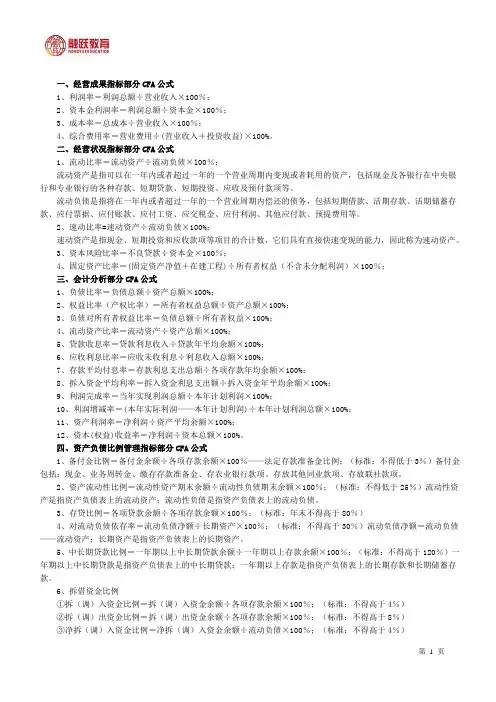
一、经营成果指标部分CFA公式1、利润率=利润总额÷营业收入×100%;2、资本金利润率=利润总额÷资本金×100%;3、成本率=总成本÷营业收入×100%;4、综合费用率=营业费用÷(营业收入+投资收益)×100%。
二、经营状况指标部分CFA公式1、流动比率=流动资产÷流动负债×l00%;流动资产是指可以在一年内或者超过一年的一个营业周期内变现或者耗用的资产,包括现金及各银行在中央银行和专业银行的各种存款、短期贷款、短期投资、应收及预付款项等。
流动负债是指将在一年内或者超过一年的一个营业周期内偿还的债务,包括短期借款、活期存款、活期储蓄存款、应付票据、应付账款、应付工资、应交税金、应付利润、其他应付款、预提费用等。
2、速动比率=速动资产÷流动负债×100%;速动资产是指现金、短期投资和应收款项等项目的合计数,它们具有直接快速变现的能力,因此称为速动资产。
3、资本风险比率=不良贷款÷资本金×100%;4、固定资产比率=(固定资产净值+在建工程)÷所有者权益(不含未分配利润)×100%;三、会计分析部分CFA公式1、负债比率=负债总额÷资产总额×100%;2、权益比率(产权比率)=所有者权益总额÷资产总额×100%;3、负债对所有者权益比率=负债总额÷所有者权益×100%;4、流动资产比率=流动资产÷资产总额×100%;5、贷款收息率=贷款利息收入÷贷款年平均余额×100%;6、应收利息比率=应收未收利息÷利息收入总额×100%;7、存款平均付息率=存款利息支出总额÷各项存款年均余额×100%;8、拆入资金平均利率=拆入资金利息支出额÷拆入资金年平均余额×100%;9、利润完成率=当年实现利润总额÷本年计划利润×100%;10、利润增减率=(本年实际利润——本年计划利润)÷本年计划利润总额×100%;11、资产利润率=净利润÷资产平均余额×100%;12、资本(权益)收益率=净利润÷资本总额×100%。
定量分析类财务:资金的时间价值。
投资:是对未来事件进行评估。
储蓄:是延迟的消费。
也即用现在的消费换取将来的消费。
一、单一现金流的计算:(1)(1)p pnp np FVFV PV i PV i =+⇒=+ sp i i m=p n m n =⨯ 利率(i ),收益率(r 或y ),增长率(g ),FV 未来现金值,PV 当前现金值, 票面利率(s i )又称年度回报率(APR i ):s APR p i i mi ==实际年利率(EAR )(1)1EARp m i i =+-二、连续复利求FV/PV : ininFVFV PVe PV e =⇒=三、连续复利求有效年利率:1i EAR e =- [1]i APR Ln EAR ==+四、年金——相等的连续现金流 终身年金的现值:10P PPMT PV I =普通年金的FV :(1)1[]pn p p pi FV PMT i +-=五、年百分率:s p i APR m i ==⨯有效年利率:(1)1mpEAR i =+- 六、持有期收益率 : 1V HPR V =-期末期初七、货币加权收益率=内部收益率(IRR)八、时间加权收益率=几何平均数九、银行贴现基准:十、实际年收益率:十一、货币市场收益率: =绝对频数相对频数样本总数十二、算术平均数: 总体:-⎛⎫= ⎪⎝⎭0BD F P 360r F t =+-365/tEAY (1HPY)1⎛⎫= ⎪⎝⎭MM 360r HPY t 12NX X X Nμ++=1nii XX n==∑样本:几何平均数:加权平均数:投资组合的平均年回报率:十三、方差和标准差 总体:样本:变异系数: 或夏普比率:或十四、概率P(X):事件X 发生的可能性 特点: 其中Xi 为一组互斥集体无遗漏事件 概率分布的数字特征:期望/预期: 方差、标准差——风险衡量()112NN X X X μ=1G r =112233123..................N NNw X w X w X w X w w w w μ+++=+++11tt t V R V -=-221()Nix i x xu N σ=-=∑x σ=221()1nii x xXS n =-=-∑x S =x xσμ=xS X =p Fp R R S -=p FpR R σ-=-=夏普比率P FXR R σ=XXσCV μ0P(X)1≤≤1()1Nii P X==∑()1()Ni i i E X X P X ==∑[]()()()2222221()()x Ni i i E X E X E X E X E XXP X σ==-=-⎡⎤⎣⎦=∑其中x σ=(){}1[[]][[]][,][][()]Nii i XY XE X Y E Y Cov X Y NE X E X Y E Y σ=--===--∑总体协方差:=XY XY X Y COV r σσ协方差和联合概率=XY XYX YCOV r σσ相关系数: 投资组合的预期回报和方差 =++=++22222P 1122121,222221122121,212σw σw σ2w w COV w σw σ2w w r σσZ 值分布:Roy 安全第一条件——最佳投资是安全第一比率SFR 最大的组合总体均值的置信区间称为显著程度称为显著水平 可以以总体平均值的样本估计值为中心构建置信区间α是显著性水平,等于1 -用%表示的置信水平。
cfa一级词汇
CFA一级考试涉及的词汇主要包括金融和投资领域的专业术语和概念。
下面是一些常见的CFA一级考试词汇:
1. 资产配置(Asset Allocation):投资组合中不同资产类别的分配比例。
2. 资产负债表(Balance Sheet):一家公司在特定日期上的资产、负债和股东权益的快照。
3. 基点(Basis Point):表示利率或投资回报率的一种测量单位,相当于1/100百分点。
4. 基金经理(Fund Manager):负责管理投资组合的专业人员。
5. 财务杠杆(Financial Leverage):使用借款或其他负债来增加投资回报率的策略。
6. 期货合约(Futures Contract):一种标准化的合约,约定在未来某个日期以特定价格交割某种商品或金融资产。
7. 净现值(Net Present Value):将未来现金流折现到当前时点的价值。
8. 风险溢价(Risk Premium):投资回报率高于无风险回报率的额外回报。
9. 投资组合(Portfolio):持有多种不同资产的集合。
10. 股息收益率(Dividend Yield):股票每年支付的股息与股票价格的比率。
以上只是一些常见的CFA一级考试词汇,实际考试中还会涉及更多的专业术语和概念。
考生需要全面掌握相关词汇,并理解其在金融和投资领域的含义和应用。
cfa一级笔记
CFA一级笔记主要包括以下内容:
1. 金融市场与资产类别:包括全球金融市场概览、资产类别和金融产品概述等内容。
2. 数量方法:包括财务数据分析和处理、统计学、概率论和回归分析等内容。
3. 经济学:包括微观经济学、宏观经济学和国际经济学等内容。
4. 公司财务:包括财务报表分析、公司估值和资本结构等内容。
5. 投资组合管理:包括投资组合理论、投资组合构建和风险管理等内容。
6. 固定收益投资:包括固定收益市场和产品、债券估值和风险管理等内容。
7. 权益投资:包括股票市场和产品、股票估值和风险管理等内容。
8. 衍生品投资:包括衍生品市场和产品、衍生品估值和风险管理等内容。
9. 另类投资:包括房地产、私募股权和对冲基金等内容。
10. 道德与职业准则:包括道德和职业准则、合规和监管等内容。
此外,CFA一级笔记中还可能包含一些重要公式和概念,例如现值公式、终值公式、有效利率、单资产和两资产等。
这些公式和概念对于理解CFA一
级考试中的金融概念和问题至关重要。
超详细的CFA一级考试的经验分享CFA考试遵循earlybird原则,就是越早报名越优惠。
所以建议大家可以在每次考试之前大约10个月报考第一档,最便宜;第二档涨了大约600多RMB;第三档就贵的多了。
所以如果打算好了要去考试的话,建议还是早点报名的好。
而且提前报名也给自己一个学习时间上有一个约束,考试就一定要考,不至于拖拉,也有更多的复习时间来备考。
给自己一个学习的压力来促使自己有更多的学习动力。
CFA institue一般每年都会调整下报名费用,多少会涨那么20~30刀,我去年L1是390刀的registrated fee加上600刀的考试费,pass了L1之后再报名L2就只需要缴纳考试费了,前几天我报2010年6月的L2是620刀。
所以三级考试都是一次pass的话,目前的考试费用大约在2,250USD左右,汇率如果按照6.9算,也就是15,525RMB,算上买notes计算器等资料钱,算上非京沪穗三地考生的车马费用,全部成本大约2wRMB(京沪穗三地考生可省3k)。
关于教材方面:以前CFA institute没有强迫你买教材,就是所谓的curriculum(6大本)。
但是后来CFA institute发现大家都不看教材的,而是去看各种培训机构的辅导用书,所以CFA institute就很不爽,开始强制卖教材给你。
所以就有了现在的报名费里面220刀的所谓的教材费。
个人觉得对于L1来说,教材真的没什么用处。
但是这里岔句话去说,对于想系统学习下金融知识而并非单纯追求证书的非科班考生来说,教材可能作用还是很大的。
如果单纯为了通过考试,Schweser出的那套notes(5小本)足够了。
Q&A:除了notes之外,别的还需要买什么?一般淘宝卖家里面都会有几种notes的套餐,我只买了最简单的那种:notes+practice exam(也是Schweser出的,2小本)+计算器(BA II)+Standards of Practics Handbook(附赠)+公式表(附赠)。
Quantitative1010365/:D 360360:==360:1360A :(1)1Continuously compounded rate of re BD BD MM BD t P P CF Holding Period Yield HPY P FV P Bank Discount Yield r F t FV tr Money Market Yield r HPY t t r Effective nnual Yield EAY HPY -+ =- ⨯⨯ =⨯=-⨯ =+-()12turn: r ln ln 1cc s HPR s ⎛⎫==+ ⎪⎝⎭23653651111(1)(1)21;;);1t tTime weighted Money weighted nini Arithmetic Weighted i i Geometric Geometric Arithmetic Harmonic ni i iy BEY HPY EAY R R IRR Xn X X W X X X X X n X L ⨯--===+=+=+=====<==∑∑∑(1)100y n +⨯2222111[()]2Excess kurtosis = Sample kurtosis - 3()();:;:;111nnniiii i i x X ks Range MaxValue MinValue XXXX MAD PopulationVariance SampleVariance s MAD n nn P k Coefficient of Variat μμσσ===-≤= ----===<-≥- ∑∑∑切比雪夫不等式::;xp fpsion CV XR R Sharp Ratio σ=- =越大越好Excess Kurtosis=Sample Kurtosis 3()1()Odds of event=;Odds against of event=1()()()(|)()(|)();()()()()()=0()()()()(|)()P E P E P E P E P AB P A B P B P B A P A P AorB P A P B P AB P AB P AorB P A P B P AB P B A P A ---=⨯=⨯=+-=+=一般条件:互斥事件:;贝叶斯公式:(|)()()(1)()x x n xn P A B P B P x C P P P A -⨯=⋅⋅-=;贝努力实验:2221,2121,21111222212221122121,21;()[()()][()()]()[()()][()()]()();290% Confidence interval for X is 1.65 ; 95% for 1.96A B A B n p p i i i Cov Cov P A B P A E r P B E r P A B P A E r P B E r E R w E R w w w w Cov X s X s ρσσσσσ===⋅-⋅-+⋅-⋅-=⋅=++±±∑2) ; 95% for 2.58~(,),;()1()(Roy's Safety-first Ratio=;Minimum Acceptable Returnp LL pX sx X N Z F z F z E R R R μμσσσ±-=-=--=/2/20000000000Confidence interval: point Estimate;One tail:,;,;Two tail:,Reject :;F X Z X Z X Z H H H H H H H test statistic critical value αααααμμμμμμ=±≥<≤>== >中心极限定理:0ail to reject ::~(0,1);:~(1)H test statistic critical value X X Z test Z N t test t t n < -=-=-22221121222212121/222212121(1) :~(1);:(S S )~(1,1)Test for equality of means: t-statistic=(Sample Variances assumed unequal);t-statistic=PPs n s chi Square test x x n F test F F n n s x x x x s s s s n n n σ--=--=>----⎛⎫++ ⎪⎝⎭条件:1/222(equal)n ⎛⎫ ⎪⎝⎭Portfolio Management22221,21212221122121,2,,2()()():()[()]pM f p f pM i mkti i i mkt mktmkti f i M f p fpCov w w w w Cov E R R CML E R R Total Risk systematic Risk unsystematic RiskCov SML CAPM E R R E R R R R Sharpe Ratio ρσσσσσσσσβρσσβσ==++-⎡⎤:=+⎢⎥⎣⎦= + ==⨯=+-- =;()();'()()Mp f M f pp fp p f p M f pM Squared R R R R R R Treynor Measure Jensen s R CAPM R R R R σσαββ-=---- ==-=---Economics%;1,;1,%Pr %;0,normal good(0<<1,necessity good;>1,Luxury);e 0,inferior good%%%Price of related g p p i i i i QOwn price elasticity e elastic e inelasticice QIncome elasticity e e e IncomeQCross elasticity ∆- =><∆∆ =><∆∆ =∆;0,;0,oodbreakeven point if AR=ATC(Perfect competition);TR=TC(imperfect competition)shutdown point if AR<AVC(Perfect competition);TR<TVC(imperfect competition)TR=P Q;AR=TR/Q;c c e substitute e complement><⨯MR=TR/QTC=TFC+TVC;MC=TC/QAccounting profit = total revenue - total accounting costsEconomic profit = Accounting profit-implicit opportunity costs=total revenue-explicit costs-implicit costs Normal p ∆∆∆1110rofit = accounting profit - economic profit=;x y x nyNominal GDPGDP deflator=Real GDP ()()()();Fiscal budget deficit=Excess over dome xy yMRS n xQ P Base BaseQ P GDP C I G X M C S TG T S I X M ∆=-∆⨯⨯=⨯⨯=+++-=++-=---用替代,用1替代currentBase PeriodRe [stic investment+trade balance Price CPI=100Price 1Money multiplier =Reserve MV=PY;Real money supply Velocity of money=Price level Real GDP :Nom al Inflati requirementFisher Effect R R E ⨯ ⨯⨯ =+]1Fiscal multiplier =;Marginal propensity to consume1(1)Real Exchange Rate(d/f)=nominal forex rate 1domestic interst (d/f):(d/f)on MPC MPC t foreign CPIdomestic CPIForward No Arbitrage Forex Rate Spot =-- ⨯+- =rate 3601foreign interest rate 360tt ⨯+⨯Equity001111Trigger Price();Trigger ()11Pr ice Weighted Index=number of stocksPrice-changeEqual Weighted Index =(1+) Equal Weighted In ni i nii Arithmetic IM IMLong P price Short P MM MMPinitial index valuen==-+=⨯=⨯-+⨯∑∑1110dex current total market valueMarket capitalization-weighted index=base year index valuebase year total market valueOne-year DDM:;Multiple-y 11Geometric n ps pss s X initial index valueD P k D P P k k ⨯⨯==+++12020ear DDM:...1(1)(1)(1)FCFE=CFO-FCInv+net borrowing;FCFF=CFO-FCInv+Int(1-t)CFO=NI+Dep-Increase in working capital;net borrowing -debt principal+new debt issues P (1n n n ns s s s ns D P D D P k k k k FCFE k =++++++++==+0110100000111) :;(1);(1);:[()](1)///;/nni s s f i M f D DGordon Growth Model P D D g g RR ROE payout ratio ROE payout ratio k g EPSCAPM k R E R R P P D g E D E Payout Ratio Payout Leading P E Trailing P E E k g k g E k g β===⨯+=⨯=- ⨯ =-=+-+ === ===---∑(1)Enterprise Value=MV of common stock+MV of Pre-stock+MV of Debt-Cash and Investment Market Value of equity/;Common equity=total asset-total liabilities-pref Book Value of equityRatio g k g P B Ratio MV ⨯+- ==erred stockAlternativeNAV Per Share Assets - Per Share LiabilitiesProb (1)Appraisal price NOI /Market cap rate;NOI=Income-Operating Expense Market cap rate Benchmark NOI /Benchmark trans nSuccess nCF Venture Capital NPV CF i = =⨯-+==()()()()action price After Tax Net Income NOI D INT *1t After Tax Cash Flow ATNI D PRN principal repayment NOI TAX PRN INT =---=+-=--+Derivative()()floating rate at settlement forward rate 360notional principal 39361+floating rate at settlement 360 rincipal ( )360Option v days FRA FRA days daysNet Fixed Rate Payment P Fixed rate LIBOR ⎡⎤-⨯⎢⎥=⨯=⎢⎥⎢⎥⨯⎣⎦=⨯-⨯;期前,期后()0000alue intrinsic value time value /1covered call S ;Breakeven=S c;Maximum Gain= X (S c)protective put S ;Breakeven=S ;Maximum Loss= X (S )Tfc X R S pp p p =+++=+=---=++-+-cFixed Income112n tt=1t 0Full Price Clean PriceAccrued Interest Accrued interestt PVCF Macaulay duration=PVCF ()Macaulay duration Modified duration=1+periodic market yield Effective Duration=T CouponT T P P P P y+0/2Δy 21absolute yield spread Absolute yield spread =high yield-low yield;Relative yield spread=benchmark bond yieldsubject Yield ratioOptionbondoptionfree bondPut Call OptionP V V V STRIPS Maturity 10111(1)1 bond yield benchmark bond yieldTax Free YieldTax equivalent yield1tax rateOAS Z-spread - Option cost(Z-spread > Nominal Spread, if spot Yield is upward sloping)(1)(1)(1)(1);TT T S f f ff 00n 2N MRT 2Face valueZero coupon bond value=(interest rate risk )(1+)2Reinvestment Income=PV (1+r )-FV-Coupon Total percentage price change=duration effect + convexity effect [MD ()][Conv ()S i Py y P最大]Dollar duration duration bond price 1%(100)PVBPduration bond price 0.01%(1) [Duration PV ]bp bp 不求,算出两个相减也可计算FSAA=L+E; E=CC+R/E; R/E R/E +NI-Div; A=L+CC+R/E +Revenue-Expense-Div current assets Current ratio =current liabilitiescash + marketable securities + A/RQuick ratio =current liabilitiescash Cash ratio =E B B =+ marketable securitiescurrent liabilitiescash + marketable securities + A/RDefensive interval=Average daily expend annual salesReceivables turnover =A/R Inventory turnover =Payables turn COGSInventory over =A/P365Average receivables collection period =receivable turnover365Average inventory processing period =inventory turnover 365Average payment period =payable Cash conversion c turn yc overPurchasePretax margin =total debt total debtD/E ratio=;D/A le = collection period + inve ratio=Equtiy AssetRevenueWorking Capital turno ntory period - payme ver=;Working Ca Average Working Capital nt period EBT Sales pital=Current Asset-Current LiabilityInterest Coverage EBIT+Lease PaymentFixed Charge Coverage=Interest+Leasr Payment Return on assets (ROA) =Return on equity(ROE) Net =ROE=EBITInterestNIAsset NIEquity=Profit Margin Asset Turnover Financial Leverage Tax burden Interest burden EBIT Margin Asset Turnover Financial Leverage =ROE=EBT NI Sales AssetSales Asset EquityNI EBIT Sales Asset EBT EBIT Sales Asset Equit ⨯⨯⨯⨯⨯⨯⨯⨯=⨯⨯⨯⨯LIFO Reserve COGS LIFO Reserve taxable income tax rate=tax payableIncome tax expense=tax payable+DTL-DTAReported effec END BGN FIFO LIFO FIFO LIFO yInventory Inventory Purchase COGS Inventory Inventory COGS =+-=+=-∆⨯∆∆income tax expensetive tax rate=pretax incometax payableeffective tax rate=pretax incomeCorporate Finance120120101100...(1)(1)(1)(1)1(1):();;(1);nnniii d d ps ps c spsps s f m f s s Asse CF CF CF NPV CF k k k CF CF IRR NPVPI CF WACC W k t W k W k D k PCAPM k R R R D D D k g P g RR ROE payout ratio ROE payout ratio P k g EPSββ==+++++++=+=+=⨯-+⨯+⨯==+-=+==⨯=- ⨯ =-∑Pr ;[1(1)]1(1)cost of capital change :Break Point=weight of capital structure()();()()(Equityt oject Asset D t EDt EMCC Q P V S TVC EBIT Q P V FDOL DFL Q P V F S TVC F EBIT Interest Q P V F IQ P DTL DOL DFL βββ==⨯+-⋅+-⋅----====--------=⨯=)();365365365;//Net working capital=Current Asset-Current Liabilitie Breakeven OperatingBE V S TVCQ P V F I S TVC F IF I FQ Q P V P VCash Conversion Cycle Purchase Inv COGSCOGS Sales Purchase Inventory A R A PC --=------+==-- =+-=∆+365/()(1)11tdiscount ost of trade credit EAR discount=+--史上最全的CFA复习笔记,爱不释手T-bill rates是nominal risk-free ratesnominal risk-free rate= real risk-free rate + expected inflation ra te风险种类:default risk违约风险liquidity risk 流动性风险maturity risk 久期风险(利率风险)EAR=e^t-1贴现率=opportunity cost,required rate of return,cost of capital ordinary annuity在期末产生现金流annuity due在期初产生现金流永续年金perpetuity PV=PMT/(I/Y)对于同一个项目IRR和NPV结论相同:IRR大于必要收益率则NPV为正,否则NPV为负如果公司目标是权益所有人财富最大化,那么始终选择NPV(通常都是这样)HPR(持有期回报)=(期末值-期初值)/期末值或者(期末值-期初值+现金)/期末值Time-weighted rate of return时间的加权平均值,(1+HPR1)(1+HPR2)…即几何平均数如果组合处于高上涨期,时间加权平均会比金钱加权平均小,反之则大。
年金现值公式系数表
摘要:
1.介绍年金现值公式
2.解释年金现值公式系数表
3.说明如何使用年金现值公式系数表
4.举例说明年金现值公式系数表的应用
正文:
年金现值公式是一种计算一系列定期支付现值的方法,主要用于财务领域。
在年金现值公式中,有一个重要的部分是系数,这些系数是根据一定的利率和期数计算得出的。
年金现值公式系数表就是把这些系数整理在一起,方便人们在计算年金现值时查找和使用。
年金现值公式系数表一般包含两部分,一部分是利率,另一部分是期数。
在计算年金现值时,需要根据实际情况选择合适的利率和期数,然后在对应的位置查找系数。
系数的选取取决于利率和期数的乘积,这个乘积被称为“年金现值系数”。
例如,如果一个人每年都会收到10000 元的年金,年利率为5%,想要计算出这些年金的现值,那么首先需要找到年金现值系数。
在年金现值公式系数表中,查找5% 的年利率和1 年的期数,可以找到对应的年金现值系数为0.9524。
然后,将10000 元乘以0.9524,就可以得到年金的现值,即9524 元。